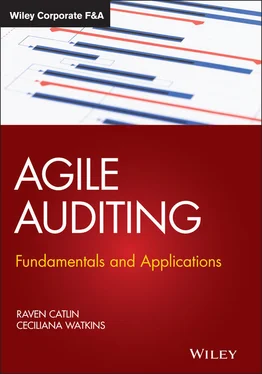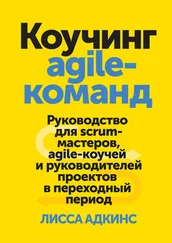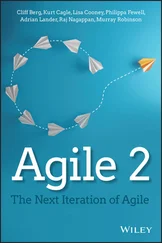1 ...6 7 8 10 11 12 ...15 Bibliography . Our journey as we wrote this book included reading over 100 books, reports, scholarly and trade journals, white papers, articles, interviews, and research papers on Agile, Agile frameworks, and Agile methodologies. The Bibliography includes references to many of the learning and discovery aids we have used in this book. We encourage our readers to seek these references, as well as many more.
Good luck, and let's start your Agile auditing journey.
PART 1 Building an Understanding of Agile and Auditing
CHAPTER 1 What Is Agile?
AGILE IS A FRAMEWORK
It felt like a no‐brainer to answer this question, as we set our sights on publishing a book on Agile auditing. Through discovery, we found that Agile has different meanings depending on your view and approach. When you develop and work with Agile, it's vital that you describe what Agile is and what it means.
Authors of other Agile publications describe it as a mindset or a methodology. Agile, for example, in Rick Wright's Agile Auditing: Transforming the Internal Audit Process (Wright 2019), he uses big “A” and little “a” to distinguish between doing Agile and being agile. Used as a noun, Wright refers to the big “A” as doing Agile internal auditing using software development methodologies. Wright's little “a,” used as a verb, describes, in general, process improvement efforts (exclusive of specific methodology) to achieve a nimbler, less wasteful process. Big “A” is essentially the technical aspect of completing an audit. Little “a” is the thinking behind being agile. Being agile is as unique to an organization as your DNA is to you. To do Agile well, you must be agile, so from here on we make no distinction between being Agile and doing Agile. Agile is both a mindset and a framework. We hope that your organization, including your audit team, will demonstrate business agility using Agile methods. Agile organizations identify changes and risks from internal and external sources, respond to those changes promptly and appropriately, deliver value to their customers, and remain sustainable. While this book is a framework providing options to implement Agile auditing, we've also provided various “recipes” with step‐by‐step examples of how to implement the framework. These recipes are as close as we get to prescribing a methodology. Remember, the recipes and the case studies provided in the text are just examples!
Agile is not a methodology itself in any discipline. It is a philosophy, a mindset, or a way of thinking to get stuff done faster based on the interests of identified customers.
It is important to note that Agile is not a methodology itself in any discipline. It is a philosophy, a mindset, or a way of thinking to get stuff done faster based on the interests of identified customers. The roots of Agile as a philosophy originated in software development. It was software developers who combined existing frameworks to create the Agile movement to complete software development projects faster. You can think of Agile as an umbrella term for a set of different frameworks and practices all based on the original software development values and principles. These values are expressed in the “Manifesto for Agile Software Development,” and the 12 principles as fashioned by the Agile Alliance are presented later in this chapter. Another key thought is that Agile methods are people‐oriented rather than process‐oriented. In Agile, people come first and people complete projects. Conversely, conventional project management and software development methods, such as waterfall, are process‐oriented.
Before we continue describing Agile, we want to clarify that there is a time and place for traditional conventional project management methods, such as waterfall. For example, certain mandatory compliance audits with repeated processes year after year might benefit from a waterfall process‐oriented approach. As a matter of fact, although there appears to be a mass adoption of various Agile methodologies in many organizations, there are still many that continue to use conventional methods successfully. We have also seen organizations transition into a hybrid Agile approach that combines aspects of both Agile and waterfall. Our Agile framework was developed specifically to help address common problems that arise when completing all audits using the traditional methodologies (i.e., waterfall).
Agile is an approach to project management based on a set of values and principles. [The Agile approach] breaks projects into smaller, incremental deliverables that go through repeated iterations to focus on customers' needs and interests. It promotes adaptive planning, early delivery, frequent inspections, continuous improvement, and flexibility to respond to change (Catlin 2020).
Agile means quick, easy, and nimble. In business, it's a way of thinking, a way of working that is increasingly part of how many of the most successful companies work (Cazaly 2017).
Agile is the ability to move quickly and easily in response to your environment. To be Agile, you must be alert to your situations, and you must be flexible, nimble, and adaptable (Catlin 2014).
Agile is a lightweight software development method that aims to be more efficient than traditional, plan‐driven development models. Agile seeks to do more with less:
More team‐level decision‐making
Faster development time
Faster response to shifting customer demands
Faster problem solving
More customer satisfaction
Smaller teams
Less expense
Less wasted effort
Fewer features in the end product that either don't work or are never used (Mathis 2013)
As these definitions show, Agile is more than a project management tool, more than a mindset, more than an ability to be nimble and responsive, and more than a method to get things done. Table 1.1contrasts three different views of Agile (LeMay 2018).
To understand Agile, it is helpful to examine the project life cycle and development life cycle. A Guide to the Project Management Body of Knowledge ( PMBOK® Guide – Sixth Edition; Project Management Institute 2017) states that “Project life cycles can be predictive or adaptive. Within a project life cycle, there are generally one or more phases that are associated with the development of the product, service or result. These are called a development life cycle … and can be predictive, iterative, incremental, adaptive, or hybrid models.”
TABLE 1.1Views of Agile
| Agile as a Methodology |
Agile as a Mindset |
Agile as a Movement |
| Practices matter more than mindset. |
Mindset matters more than practices. |
Mindset and practices are inexorably connected. |
| The practices and methods of Agile were already determined by others. |
The principles and values of Agile were already determined by others. |
I have an active role to play in determining how Agile principles and practices are articulated and applied in my team or organization. |
| Individuals within teams must collaborate and interact in prescribed and predefined ways. |
Individuals within teams must independently develop an Agile mindset. |
Individuals within team must work together toward a shared set of goals and values. |
The PMBOK® Guide goes on to explain that:
The traditional model, otherwise called waterfall, is a predictive life cycle where the project scope, time, and cost are determined in the early phases of the cycle. Any changes to scope are carefully managed. However, Agile is an adaptive life cycle and it may be iterative and incremental.
Читать дальше











